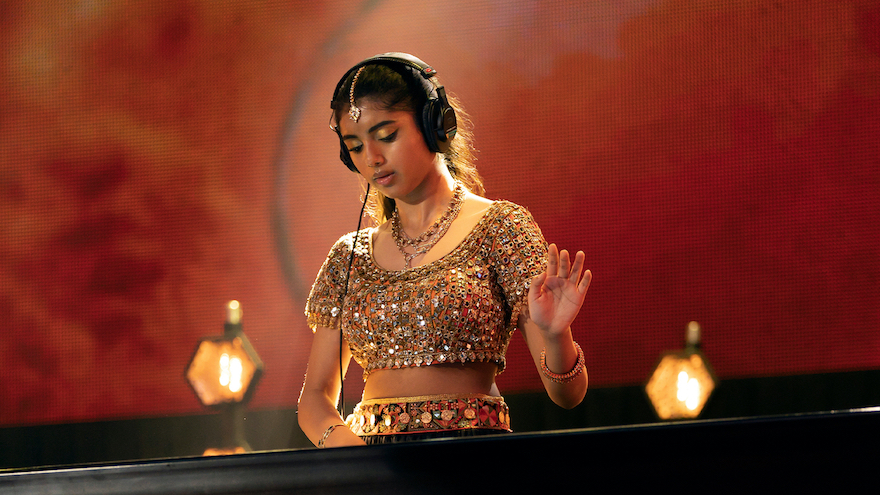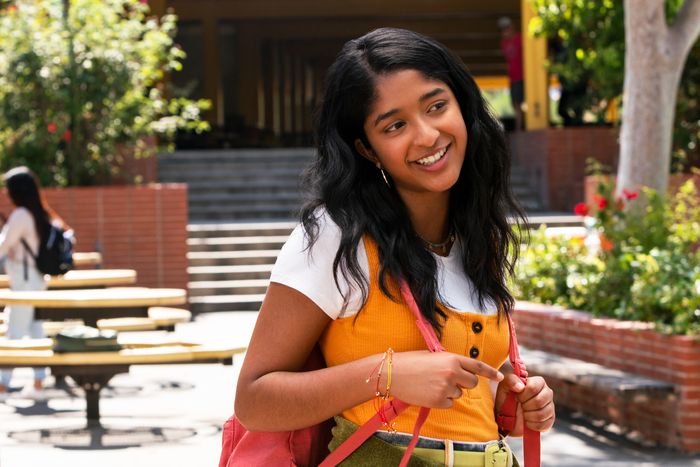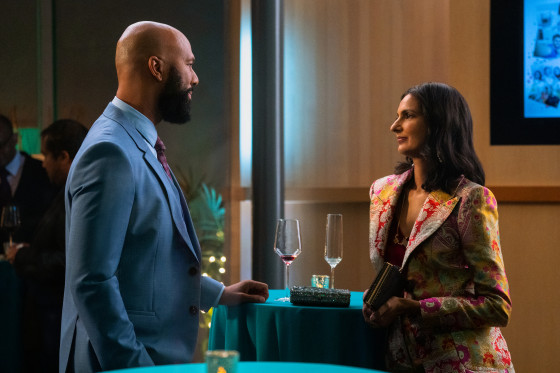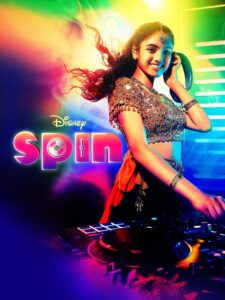Changing Stereotypes of South Asians on Screen
Representations of South Asians on American TV have remained limited for decades. But things are starting to change slowly.

(Scene from the Disney film Spin)
In January 2022, HBO Max’s And Just Like That, the Sex and the City reboot, drew the attention and ire of many South Asians. In an episode titled, “Diwali,” the show’s main character, Carrie Bradshaw, visits a clothing shop to purchase a sari to wear to her realtor-turned-friend Seema Patel’s celebration of Diwali, a holy festival for Hindus, Sikhs, Jains, and Newar Buddhists. In perhaps the most memorable moment of the episode, Carrie descends the steps of her New York City apartment wearing a red and blue lehenga with a matching floral headpiece.
This episode received mixed reviews from Indians, some of whom applauded the show’s portrayal of Seema Patel as a powerful real estate agent. Others critiqued the episode for cultural ignorance when Carrie conflates a lehenga and sari. Before attending the celebration, Seema and Carrie visited a “sari shop” where the latter sought to find an appropriate outfit. Carrie repeatedly affirms her desire to wear a sari, a type of garment with several draped yards of fabric; however, when she arrives at Seema’s house, she is wearing a lehenga, an outfit with a blouse and ankle-length skirt. And Just Like That, produced twenty-four years after the first episode of Sex and the City, is more diverse than the original series and briefly explores Seema’s life as a single, middle-aged Indian American woman. But the show contains stereotypes, such as Seema’s parents pushing her to consider an arranged marriage, that are hardly more nuanced than those in 1990s popular culture.
In the 1990s, few shows featured South Asians. The Simpsons was a notable exception. Throughout the show, Homer, the main character, would visit Kwik-E-Mart, a convenience store owned by Apu Nahasapeemapetilon, an Indian American. Apu was an over-the-top Indian caricature, voiced by Hank Azaria, who spoke in a thick accent and was known for the way he bid his customers goodbye by saying, “Thank you, come again.” This type of brown-voice performance, media scholar Shilpa Dave notes, is a part of the legacy of British colonialism that has been carried over to the United States and that accentuates stereotypes about South Asians. In 2017, Indian American comedian Hari Kondabolu directed The Problem With Apu, a documentary exploring how Apu has perpetuated racism against South Asians.
In recent years, television and film industries have made significant strides to diversify the portrayal of South Asians on screen: first, by increasing the number of programs that feature South Asian actors, such as The Big Bang Theory (CBS) starring British comedian-actor of Indian descent, Kunal Nayyar, The Lovebirds (Netflix) starring Pakistani American actor, Kumail Nanjiani, Sunnyside (NBC), featuring Kal Penn, an American actor of Indian descent and Bridgerton (Netflix) starring British actresses of Indian descent, Simone Ashley and Charithra Chandran; and second, by producing programs that center Indian characters, such as Never Have I Ever (Netflix), Indian Sweets and Spices (Bleecker Street Films), and Spin (Disney).
In the last year alone, we’ve witnessed more developed portrayals of Indian Americans, as Indian Americans are scripting, directing, and producing programming that represent their experiences. The two that stand out to me, Never Have I Ever and Spin, showcase the complexities of Indian American women’s experiences while tackling issues of race, gender, class, and religion.
***
Mindy Kaling, who starred as Kelly Kapoor in The Office, scripted and directed Netflix’s Never Have I Ever, which premiered in 2020. The coming-of-age comedy stars Maitreyi Ramakrishnan as Devi, a fifteen-year-old in San Fernando Valley, California, and is loosely based on Kaling’s own childhood experiences. The show traces how Devi comes to terms with the sudden death of her father prior to the start of the school year at Sherman Oaks High.

(Maitreyi Ramakrishnan as Devi in Never Have I Ever)
The series opens with Devi praying to Hindu deities in her household shrine. She asks the deities for popularity (being invited to parties, getting a hot boyfriend, and having thinner forearm hair). Season One tells Devi’s story as she adjusts to high school, strives for academic excellence, and navigates her familial and cultural identities as the daughter of Indian immigrants. When Never Have I Ever debuted, it garnered praise from second and third generation South Asians who could, perhaps for the first time, identify with a protagonist in American popular culture. Writer Aanika Eragam claims the show resonated with Hindus in the diaspora who perform puja, adorn saris, pursue romantic relationships, and learn to balance their identities.
Never Have I Ever should be commended for several things. First, the series has a cast of leading Indian women: Maitreyi Ramakrishnan (Devi), Poorna Jagannathan (Devi’s mother, Dr. Nalini Vishwakumar), and Richa Moorjani (Devi’s cousin, Kalama). Second, the show destigmatizes mental health concerns, a rarely acknowledged problem in Indian communities, by including scenes of Devi meeting with her therapist, Dr. Ryan (played by Niecy Nash). Initially, Devi seeks therapy to process the trauma of her father’s death. Over time, Devi’s meetings with Dr. Ryan address family dynamics, high school, and social relationships. In some Indian and South Asian households, the gravity of mental health concerns go unmentioned, especially for immigrant children. Never Have I Ever normalizes mental health, illustrating that therapy can help people work through the anxieties and frustrations of life.
Never Have I Ever also addresses social stigmas within some Indian communities, particularly around issues of suitable romantic relationships. In the show’s second season, Devi’s mother, Dr. Vishwakumar, considers a romantic relationship with a Black dermatologist, Dr. Jackson, played by Common. The portrayal of such a relationship is significant because historically, among some Hindu communities, widows were considered of low social status and were subject to practices such as widow immolation. During the nineteenth century, Hindu religious leaders and reformers such as Rammohan Roy and Swaminarayan condemned widow immolation and supported widow remarriage. In 1856, the British East India Company passed the Hindu Widows’ Remarriage Act and legalized the remarriage of widows. While attitudes towards widows in India have evolved since the nineteenth century, social and cultural stigmas continue to shape how individuals perceive widows today.

(A scene from Never Have I Ever)
The flirtation between Devi’s mom and Dr. Jackson also allows Never Have I Ever to address issues of interracial and interreligious relationships. Within some Indian communities, pressures to date or marry Indians of similar geographic, religious, and cultural backgrounds abound, as does anti-Black racism. As scholar and filmmaker Vivek Bald notes, even though some South Asians, including many Bengali Muslims, lived, worked, and shared experiences with Blacks during the early twentieth century, many are unaware of those histories and have contributed to racism against Black Americans. Never Have I Ever pushes against the pressures to avoid interracial and interreligious dating in Indian communities through the depictions of Dr. Vishwakumar’s encounters with Dr. Jackson.
Despite these important achievements, Never Have I Ever is not without flaws. For one, the series furthers the model minority myth, which characterizes South Asians, and Asian Americans more broadly, as hardworking law-abiding individuals, who have achieved a higher degree of success than other racial minorities. The show depicts South Asian Americans as students who excel academically, major in STEM fields, and pursue lucrative careers. The show’s first season obfuscates the diversity of the Indian American experience, especially since many Indian immigrants are from low-income backgrounds and support their families with blue collar jobs. By presenting Indians as a model minority, the show suggests that anyone can be successful if they work hard, thereby ignoring systemic racism and the centuries of laws enacted to keep people of color in poverty.
***
Shifts in stereotypical portrayals of South Asians are not only occurring in television series, but also in films. One such film is Spin, a 2021 Disney Channel original movie, written by Josh A. Cagan and Carley Steiner and directed by Manjari Makijany. The film stars Avantika Vandanapu as Rhea Kumar, an Indian American teen living in a multi-generational household. She lives with her father, Arvind (Abhay Deol), her brother Rohan (Aryan Simhadri), and her maternal grandmother Asha (Meera Syal), in California where her family owns and manages a restaurant, “Spirit of India.” Rhea navigates the stressors of high school: balancing her studies, her family responsibilities of taking care of her father and the restaurant, and her social life, all while trying to pursue her passion for music.
 Rhea and her friends, who are part of an after-school coding club, are preparing to host a Holi festival at their school. One Sunday while Rhea works the evening shift at her family’s restaurant, she meets Max, a transfer student from England, and his mother. After discovering their shared interest in music, Max (Michael Bishop) introduces Rhea to the world of disc-jockeying but grows increasingly jealous and intimidated by her when her natural talent outshines his. Meanwhile, Rhea’s teacher, Naomi (Kyana Teresa), worries Rhea is taking on too much responsibility and being robbed of her adolescence, a concern she shares with Arvind during a parent-teacher conference. Throughout the film, Rhea explores her musical interests, a talent she shares with her late mother, and wins a competition against Max who plagiarized her musical compositions.
Rhea and her friends, who are part of an after-school coding club, are preparing to host a Holi festival at their school. One Sunday while Rhea works the evening shift at her family’s restaurant, she meets Max, a transfer student from England, and his mother. After discovering their shared interest in music, Max (Michael Bishop) introduces Rhea to the world of disc-jockeying but grows increasingly jealous and intimidated by her when her natural talent outshines his. Meanwhile, Rhea’s teacher, Naomi (Kyana Teresa), worries Rhea is taking on too much responsibility and being robbed of her adolescence, a concern she shares with Arvind during a parent-teacher conference. Throughout the film, Rhea explores her musical interests, a talent she shares with her late mother, and wins a competition against Max who plagiarized her musical compositions.
Spin is to be commended for several reasons. First, Spin is the first Disney film that features a South Asian protagonist. Second, the film challenges the model minority myth by illustrating that South Asians pursue interests and potential careers outside of STEM fields. Third, Spin focuses on Rhea’s self-journey and her interests in music. Rhea seems to have a crush on Max, at least initially, but any hints of romance are absent for the remainder of the film. The coming-of-age story leads viewers to focus on Rhea and her development as an individual.
Significantly, Spin weaves Rhea’s Indian American identity seamlessly into her experience as a high school student through her selection of clothing and music. Subtle references made throughout the film, particularly concerning music and dress, ranging from her grandmother wearing a salwar kameez (tunic and trousers) and Rhea wearing kurtas (a long tunic) on top of jeans, or a lehenga top and a tika (forehead ornament) with pants for her competition, visually depict her hybrid identities as an Indian American. Rhea’s embrace of her Indian identity illustrates that migrants often resist assimilation into mainstream U.S. culture.
***
Spin, like Never Have I Ever, participates in a broader shift in television and film that centers on South Asian cultures and traditions. For many individuals, television and film are among the primary means through which they learn about various cultures, religions, and traditions. In the 1990s, The Simpsons was one of the few shows through which viewers learned about Indian Americans and Hindu culture, albeit through stereotypes.
While much has been done to combat stereotypical portrayals of Indians on screen, much more can be done to nuance the depiction of South Asians in popular culture. First, television and film ought to represent the diversity of South Asian traditions broadly by casting actors of various backgrounds, including those from places other than India, like Nepal, Pakistan, and Bangladesh. Second, television and film can continue to develop characters who come from various socio-economic backgrounds, dismantling presentations of South Asians as a model minority. Third, pop culture depictions of South Asians should explore issues of gender and sexuality beyond cisgender heterosexual romances so that they reflect a more accurate representation of South Asian Americans today.
Spin and Never Have I Ever are taking us in the right direction away from The Simpson’s Apu. But that is a low bar from three decades ago, and we still have a long way to go.
Bhakti Mamtora is Assistant Professor of Religious Studies at the College of Wooster and a Sacred Writes/Revealer writing fellow. Her research examines orality, textuality, and canonization in South Asian and diasporic Hindu traditions.
***
This article was made possible in part with support from Sacred Writes, a Henry Luce Foundation-funded project hosted by Northeastern University that promotes public scholarship on religion.